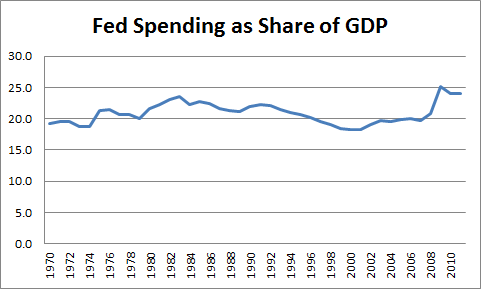A number of commenters make good points regarding spending cuts in the federal budget.
I often argue that we can't achieve budget sustainability on spending cuts alone. That's passes for a bold argument these days, because pretty much everyone agrees that government spends too much, right? So the only point of contention is whether budget sustainability should involve tax increases as well.
But what, specifically, does government spend "too much" on? Defense? Some say so, and there are clear inefficiencies there, but as a share of the economy, it's not historically high. What about agriculture subsidies; industry subsidies; all those tax expenditures (spending through the tax code) for kids, research, investment, health care, housing, education?
The historical record, shown below, shows spending by the federal government as a share of GDP wiggling around a pretty narrow range until the Great Recession, where it shoots up, by necessity. But it's already coming down... too soon, in my view, given the ongoing weakness. But the point is if you adjust for the business cycle and the important countercyclical function of government spending in recession, it's not jump-out-at-you obvious that there's a spending problem. (There's very clearly a revenue shortfall problem.)
More to the point -- graphs like the one below are interesting from a macro perspective but they're of no use in answering questions like "does government spend too much?" Or "where should we cut?"
For that you have to look at each spending function and you have to do some analysis -- is this a function government should provide or is it a market function? The sweeping framing we typically employ is far too vague.
If I told you government is spending over $3 trillion per year in recent years, you might well say, "surely there's money to be saved there." But where? Without more thought, we should expect to end up right where Rep. Ryan's new budget goes -- slashing deeply into spending with no context.
It's the "cut, baby, cut" version of "drill, baby, drill." (This piece by my landsman Jonathan does a nice job adding some much needed, granular context to the Ryan plan.)
I've often thought it would be smart -- though impractical -- to undertake some kind of a zero-based budgeting exercise with the federal budget. Maybe we could make this a national project... do it on TV as a PBS series or something... we'd pop some corn, all get together and pore through the books of America, Inc. Maybe not quite fun as American Idol, but I'd watch it, and I'll bet Ezra Klein would too. And when it was over, perhaps we'd all have a better idea of what we're talking about.
At any rate, I appreciate the fact that a number of commenters challenged this formulation.

Source: OMB
This post originally appeared at Jared Bernstein's On The Economy blog.
